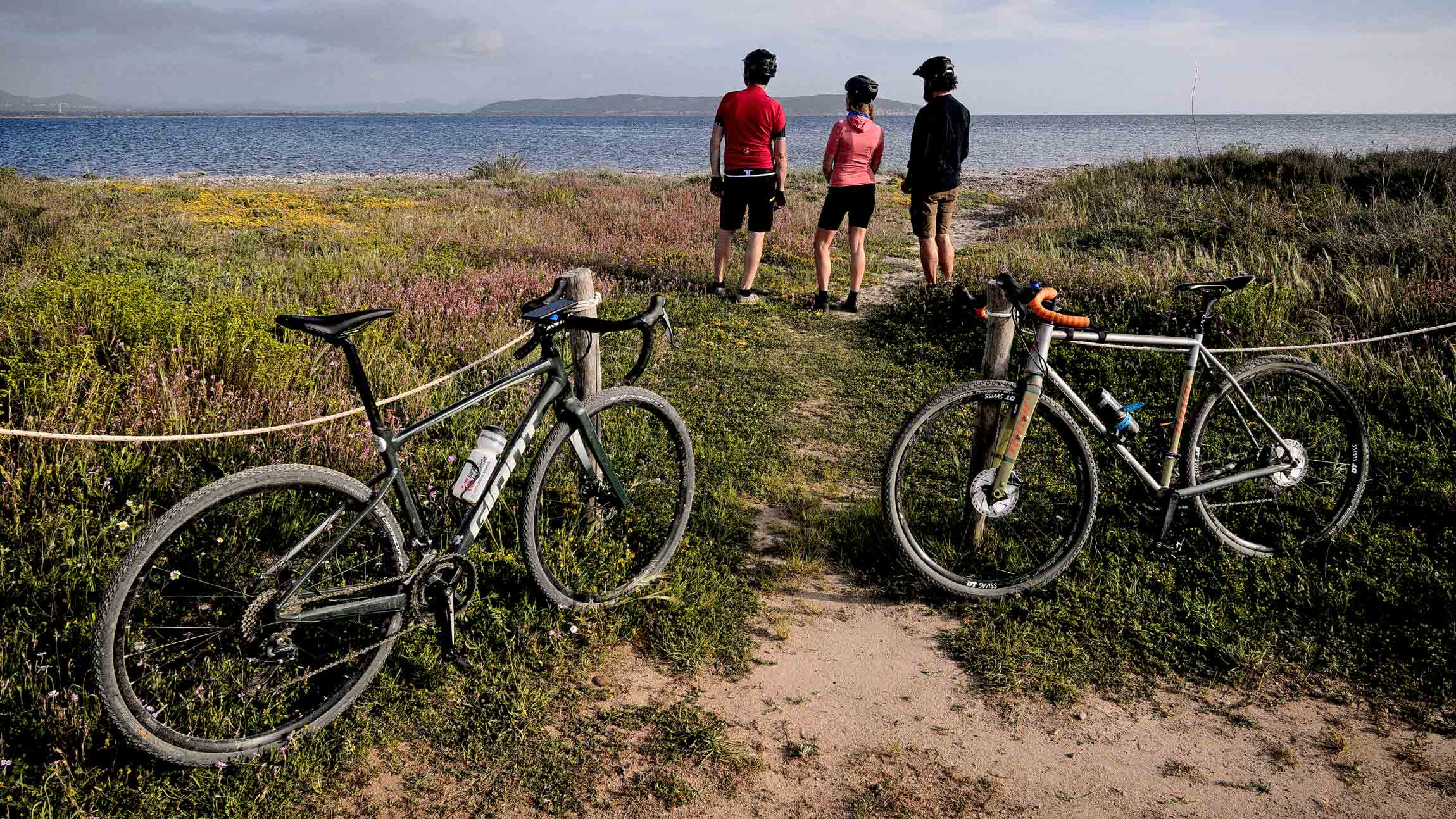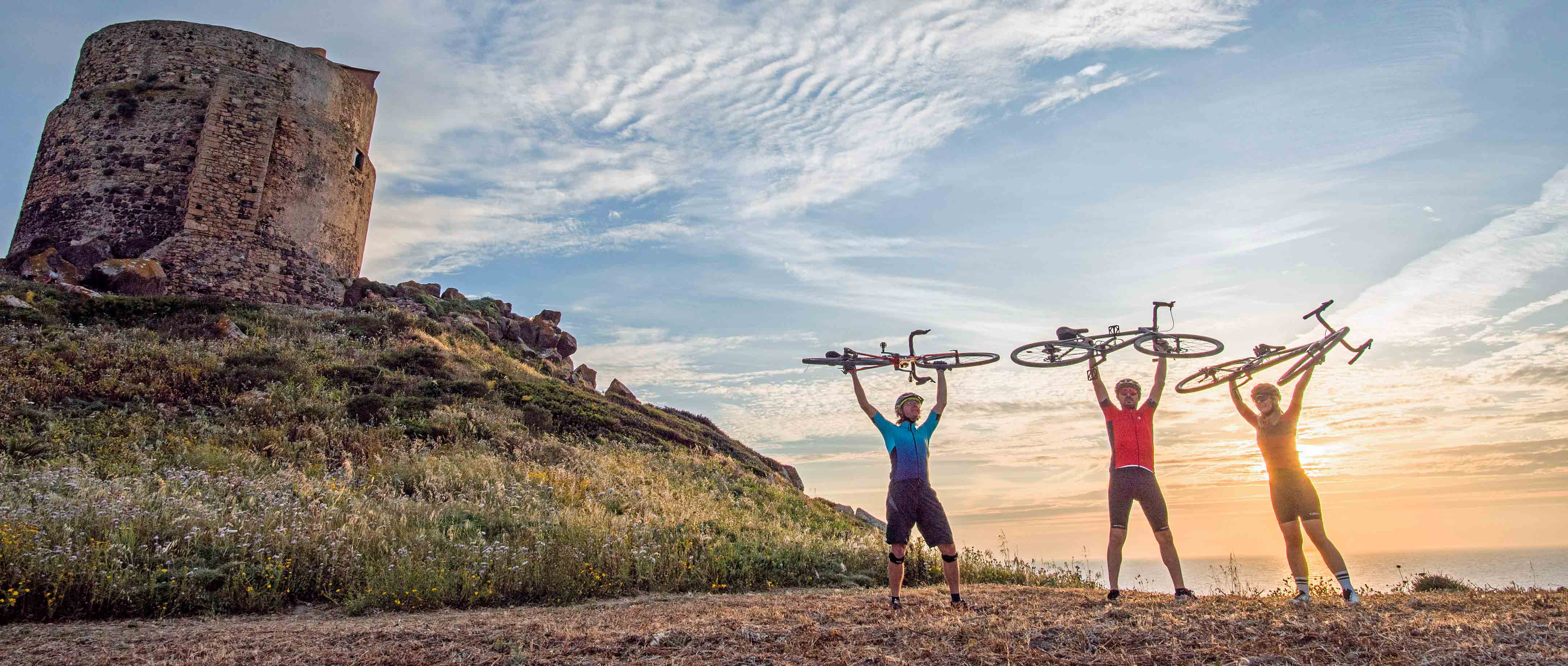The island of Sardinia might not be your first choice if you were asked to name an iconic Italian gravel riding destination, but that’s part of its charm. As yet undiscovered by the majority of away-from-the-road cyclists, the mix of wild landscapes, fantastic food, a perfect Spring/Autumn climate and plenty of adventurous riding makes it a beguiling choice for a future trip. We chat with professional gravel guide Lieven Loots to find out why he made the island his home and what the connection is between his love of archaeology and his love of gravel riding.
Anyone who has ever been on a guided cycling holiday will know that one of the first questions you ask your guide is “How did you first get into guiding as a job?” Even though we knew it would make Lieven roll his eyes in mock horror, he also knew it was part of his job to be unfailingly polite and answer questions with a smile on his face, no matter how many times he has answered them before! And after all, how many other PhD-qualified Belgian archaeologists work as a gravel cycling guide on a paradisaical Mediterranean island?
“After I finished my archaeology PhD in Belgium, I moved to Italy where I started work working in a motorcycle shop, but after a year working there, I decided that was not for me. So, I started doing archaeology again and I moved from northern Italy (where the motorbike shop was) to southern Italy to join a dig. It was there that I met my wife. The problem was that the work was sporadic - two weeks here, a month here, six months there, if I was lucky. So, I was looking for an alternative to that. I moved into guiding instead because that's obviously a steady job [hopefully the irony of this statement is not lost on you all…] Initially, I started doing walking holidays on the Amalfi Coast. And after that, I also led cycling holidays for a local tour operator. Then my wife got a job in Sardinia, so we moved here. That was back in 2012. I wasn't doing archaeology anymore by then, so I started looking around and ended up working as a guide here for Saddle Skedaddle [who he still guides for now]”
The inspiration behind our conversation with Lieven was to find out more about the Sardinia Cape to Cape gravel riding holiday that he co-created with Naomi Lindfield, (head honcho at Skedaddle Italia), who also lives and works on the island. As Sardinia is still relatively unknown by gravel riders and the trails can turn super technical (i.e. more suited to mountain bikers) if you head to the wrong locations, going on a guided trip is the ideal way of letting someone else do the hard work in the background, while the customers get to enjoy the benefits. We asked him what was the inspiration for the Cape to Cape trip and how he had gone about researching the route?
“The inspiration for this trip and the specific route is because this part of Sardinia is where you will find the best gravel riding. If you go to the higher, mountainous parts of the island, you’ll find great riding, but nothing that is suited to a gravel bike – it’s all way too technical/rocky and really only suitable for mountain biking.” He told us. “To create the route, I took some trails that I already knew, because I live close to the area where the holiday takes place, but I had to go and reccie some of the sections that linked up trails that I knew and I needed to research the first part of the trip too. I’ve made sure that there’s some good archaeological basis to the route too – pretty much every day we will cycle past several archaeological sites, including the only UNESCO world heritage site on the whole of Sardinia, so I can give the groups a bit of an explanation of what they are seeing.”
Image courtesy of Lighttrapper Photography
Image courtesy of Lieven Loots
Next, we asked Lieven to try and describe what gravel riding on Sardinia is like?
“The riding in the west of the island [where the Cape to Cape trip is run] is really varied. We start with some coastal trails, some minor roads and even some beach riding on Sant’Antioco Island, then after we leave the island we’re going to be riding through an area of salt marsh close to a couple of lagoons. Next, we’re heading into the hills en route to the Campidano Plain. There’s a mix of trail types here, including some forest riding, some farm tracks and we finish the day with a long gravel climb. The third day of riding starts off relatively gently, but there are some rocky farm tracks before lunch. We’re back riding in the hills in the afternoon. The next day starts off with a 5km climb to warm up our legs, before riding a mix of rocky singletrack, smooth dirt roads and minor back roads. This day includes the longest climb of the trip, but then we take on a fast descent and have some great dirt roads to finish the day. Day 6 is a mix of dirt roads and minor paved roads, initially hilly but then we ride on the Oristano Plain and around the Cabras Lagoon, where the riding is more gentle. The final day's ride is a coastal loop right around the peninsular, which is quite flat. The trails are a mix of clifftop singletrack, dirt roads and sandy beach trails. Every day is basically different. The percentage of gravel each day varies from 30% to 70-80%. Some of the trails are pretty rocky – it’s definitely not gravel riding like the Strada Bianche.”

Image courtesy of Lieven Loots
We talked next about bikes. With the terrain and trails having so much variation, is there a perfect bike for gravel riding in Sardinia?
“I’ve cycled all of the routes on my steel-framed CX bike with 32mm tyres and I’m still alive” joked Lieven “but I would recommend something with much bigger tyres. Ideally, you want tyres around 42-45mm and set up tubeless. Run the tyres a bit softer to help take the vibrations out of the ride. Our hire bikes are Giant Revolts – the full-carbon version, with 42mm tyres set up tubeless.”
No trip to Italy would be complete without talking about food and drink. We asked Lieven for some insight into Sardinian specialities.
“Sardinia has a varied range of local foods. Despite being an island, it’s not as heavily based on seafood as you might have thought – this is for historical reasons. With so many different invaders having landed in Sardinia over the ages, the local people tended to move inland away from the sea, so many of the dishes are more inspired by the land. Having said that, we’re going to be staying close to Calasetta on the first night which is famous for locally caught tuna fish. In the same area, you'll frequently find couscous being eaten with tuna, which comes from the period when Sardinia was invaded by Arabs from North Africa. There’s a typical type of Sardinian bread called “pane carasau” which is thin and crisp and great with antipasti. For meat eaters, suckling pig or “su porceddu” is a real countryside tradition served on special occasions. You can get really good gnocchi called "maloreddus alla campidanese" or a stuffed pasta called "culurgiones", where the filling varies from village to village. Finally, there’s another local delicacy called "bottarga di muggine" which is the roe of a green mullet which are salted, pressed and dried and then either grated or cut up and which is normally served with pasta. While Sardinian wines might not be as famous as those from Tuscany or Piedmont, there are some delicious locally-produced ones. For example, from close to Sulcis you get Carignano, a really good red or rosé wine.”

Image courtesy of Lighttrapper Photography
We finished off by asking Lieven if he had any advice for gravel riders considering coming to Sardinia for the first time?
“Be prepared. “ was his initially succinct answer, but he continued “Be prepared to explore. Be prepared to go off the beaten track. Be prepared to be open to new things. For authentic things in this case, because as I said before, we're going to pass through some areas and cycle some roads where nobody else goes – almost no locals and certainly no tourists.”
If Lieven’s insight into his “small continent” home has inspired you to go and ride there, you can find out more about Saddle Skedaddle’s Cape to Cape trip here.